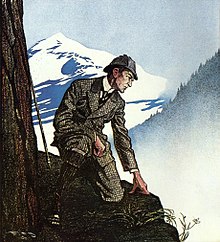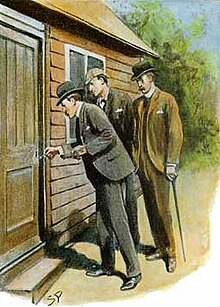The return of Sherlock Holmes
The Return of Sherlock Holmes (Original: The Return of Sherlock Holmes ) is one of Arthur Conan Doyle written collection of thirteen crime - short stories about his famous detective Sherlock Holmes and his friend Dr. Watson , published in Great Britain in 1905.
Emergence
After Doyle let Sherlock Holmes die in the story The Last Problem (published in The Memoirs of Sherlock Holmes in 1893 ), the detective was resurrected in the 1903 short story The Empty House . He had previously published the novel The Hound of Baskerville in The Strand Magazine , which plays Holmes before death, from 1901 to 1902 . The author developed a complicated narrative construction, according to which Holmes did not fall into the Reichenbach Falls in Switzerland with his archenemy Professor Moriarty , but rather hid from his opponent for some time after the death of his opponent. This episode of time will later be thematized in several pastiches .
The Empty House and twelve other crime episodes were finally published in 1905 in the anthology The Return of Sherlock Holmes . The stories had previously appeared in The Strand Magazine every month . The book was first published on March 7, 1905 by Georges Newnes, Ltd and also by Longmans for the colonies. The first edition comprised 30,000 copies. An additional 28,000 books were printed from the US first edition by McClure, Phillips & Co.
content
The book contains thirteen short stories, each about 30 to 40 pages long in the German translation. The letters in square brackets [] denote the now firmly established abbreviations.
The Empty House [EMPT], 1903
- Dr. To his utter astonishment, Watson sees his friend Holmes, who has been believed dead, who tells him how he escaped his supposed death. Together they arrest the most dangerous henchman of Holmes' archenemy Professor Moriarty , Colonel Sebastian Moran , when he tries to assassinate what he believes to be a master detective who is at home.
The Norwood Builder [NORW], 1903
- A solitary builder seems to have been murdered by his sole heir, but Holmes believes the allegations of innocence of the highly suspect. However, the case seems hopeless. Only the appearance of an additional incriminating index overnight testifies that the arrested suspect must be innocent. Holmes eventually discovers the lively murder victim hiding in his own house.
The Dancing Men [DANC], 1903
- The wife of a respected landlord is driven into despair by secret messages from dancing stick figures. As Holmes decrypts the code , he realizes that this is not just about a stupid prank. Although he can no longer prevent the violent death of his client, thanks to his knowledge he can determine the circumstances and exonerate the woman from the allegation of murder.
The Solitary Cyclist [SOLI], 1903
- A young lady is followed by a stranger when she rides her bike from her place of work and home to the local train station. Dr. Watson initially investigates alone, but remains unsuccessful. However, Holmes soon realizes that a dangerous intrigue is being spun around the young lady, and at the last moment frees her from a bad fix.
The Priory School [PRIO], 1904
- The son of an influential nobleman and a teacher disappeared from boarding school overnight. During an irritating search for clues in the adjacent moor, Holmes discovers the body of the originally suspected teacher. Investigations in the nearby inn finally convince Holmes of the sophistication of the kidnappers who left false tracks in the moor, as well as the complicity of the boy's father and his private secretary.
The Black Peter (Black Peter [BLAC], 1904)
- At the request of the police, Holmes is investigating the gruesome murder of an old whaling captain who was brutally stabbed with a harpoon in the garden shed where he usually slept . When someone tried to break into the hut during the night, it was obvious that there was more than a few old log books in the shabby house. Only because Holmes finds out the circumstances in time can he lure the perpetrator into a nifty trap.
Charles Augustus Milverton (Charles August Milverton [CHAS], 1904)
- The detective is asked by a young lady to retrieve a compromising letter, the publication of which would prevent her impending marriage. The letter is owned by professional blackmailer Milverton. As soon as Holmes and Watson break into his study, they witness the fate of Milverton from the other side and narrowly escape their highly suspicious situation.
The Six Napoleons [SIXN], 1904)
- An apparently mad burglar steals cheap duplicates of a bust of Napoleon Bonaparte and smashes them in the street. When a murder even occurs in connection with this supposedly mere destructiveness, Holmes realizes the real motive of the perpetrator and anticipates him before he can achieve his goal.
The Three Students [3STU], 1904
- In this case, Sherlock Holmes has to clarify which of three students living in a dormitory has made a copy of the secret documents of an important examination taking place the next day. Holmes is under great time pressure: the perpetrator must be found by the start of the exam so that the incident does not become public.
The Golden Pince-Nez [GOLD], 1904)
- Here Sherlock Holmes is investigating the murder of the secretary of an old history professor. The victim is clutching gold glasses as the only clue to the perpetrator. The other circumstances of the crime are highly unclear and confusing, but the extreme nearsightedness of the perpetrator, which emerges from the examination of the eye glasses, finally puts the investigator on the right track.
The Missing Three-Quarter [MISS], 1904
- The top player on a university rugby team disappeared from his hotel the night before an important game. The only clue is the print of the last sentence of a telegram on the hotel's blotting paper. Holmes uses a trick to find out to whom the message was addressed, deduces from further observations the suspected whereabouts of the athlete and discovers his double life.
Abbey Grange (The Abbey Grange [ABBE], 1904)
- A tyrannical nobleman was brutally murdered, apparently by a gang of burglars operating in the area. Due to some inconsistent details, Holmes doubts this theory and the evidence available to it. After tracking down the perpetrator and finding out why the witnesses are covering him, he shows understanding for the reasons for the crime and for the time being refrains from leading the official police investigators on the right track.
The Second Stain [SECO], 1904
- In this case, which, according to Dr. Watson is probably one of the most important of his friends, Sherlock Holmes has to find a paper stolen from the house of the European Minister in order to prevent an international crisis, even a war. The murder of a foreign agent and the investigation of the crime scene leads the detective to track down the person who is hiding the letter.
meaning
Doyles The Return of Sherlock Holmes is part of the second creative period in the Sherlock Holmes crime novels, which began with The Hound of Baskerville after the temporary death of Holmes and the author's several years' break in writing . This Sherlock Holmes volume, which is the most extensive with thirteen short stories, is one of the lesser-known works from the Holmes canon, along with His Farewell Performance and Sherlock Holmes Book of Cases .
expenditure
- Arthur Conan Doyle: The Return of Sherlock Holmes (translation: Werner Schmitz), Haffmans 1985, ISBN 3-251-20106-9
- same translation (new edition): No and But, 2004, ISBN 978-3-0369-5149-2
- Same translation (paperback): Insel paperback no.3319, 2007, ISBN 978-3-458-35019-4
- Arthur Conan Doyle: Sherlock Holmes Collected Works , Hardcover (Translator: Adolf Gleiner, Margarete Jacobi, Louis Ottmann, Rudolf Lautenbach), Anaconda-Verlag 2012, ISBN 978-3866478503
- Arthur Conan Doyle: The Return of Sherlock Holmes (Translation: Henning Ahrens), Fischer Taschenbuch 2017, ISBN 978-3-596-03562-5
See also
Web links
- Sir Arthur Conan Doyle: The Return of Sherlock Holmes in Project Gutenberg ( currently usually not available for users from Germany )
- German translations of the individual stories:
- In the empty house in the Gutenberg-DE project or The empty house in the Gutenberg-DE project Translation by Alexander Wlk (2009).
- The Norwood builder in the Gutenberg-DE project
- The dancing men in the Gutenberg-DE project
- The lonely cyclist in the Gutenberg-DE project
- The kidnapping from the convent school in the Gutenberg-DE project
- The buck in the Gutenberg-DE project
- Sherlock Holmes as a burglar in the Gutenberg-DE translation by R. Lautenbach
- The six busts of Napoleon in the Gutenberg-DE project
- The three students in the Gutenberg-DE project translation by R. Lautenbach and The three students in the Gutenberg-DE project translation by Alexander Wlk (2013).
- The golden clamp in the Gutenberg-DE project
- The missing soccer player in the project Gutenberg-DE Translation by R. Lautenbach
- The murder in Abbey Grange in the Gutenberg-DE project
- The second blood stain in the Gutenberg-DE project





